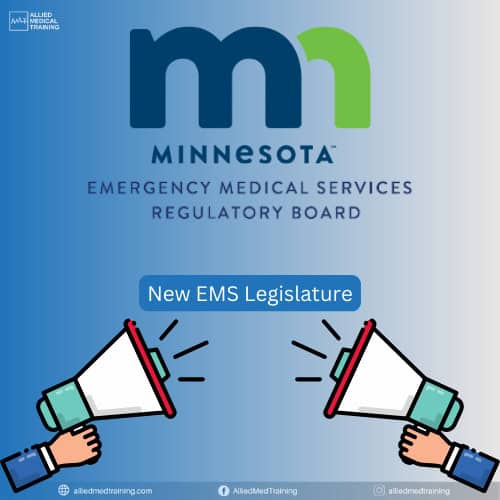
Some important changes are taking place in the EMS system in Minnesota based on a bill that was approved earlier this spring. The bill is focused on tackling the issues of the Minnesota EMS system, particularly in rural areas, struggling with long response time and lack of EMS staff. So let’s delve into a quick summary of the updates and changes!
First up, let’s look at the major legislative changes based on a bill signed into law:
There will be a new Office of Emergency Medical Services to replace the EMSRB starting on January 1, 2025, with a goal to enhance the management and oversight of EMS in Minnesota.
This new office will have three divisions:
Medical Services
Ambulance Services
Emergency Medical Service Providers
As part of the new Office of Emergency Medical Services, there will be a boost in funding ($30 million) for ambulance services to boost resources and increase response times, particularly in rural areas.
Additionally, there will be a new pilot program for alternative EMS response models to allow higher collaboration for ambulance providers in rural regions with support providers for enhanced life support services.
Next up, let’s review some changes for expired credentials for EMRs and EMTs:
EMRs:
The reinstatement period, which is after EMR certification has expired, is increased from 1 year to 4 years. Note that EMRs still cannot work on an ambulance while in their reinstatement period as their certification is expired, but they can complete a refresher course to gain it back within 4 years of expiry.
EMTs (also AEMTs, Paramedics, and Community Paramedics):
For those with EMS certification that has expired for 4 years but less than 10 years, they have from July 1, 2024 through December 31, 2025 to apply for reinstatement with the following requirements:
Evidence of completion of education requirements within 2 years prior to the date of their application
Complete a reinstatement application in the online portal with course completion and approval from the education program
Submit a recommendation from an ambulance service medical director
RN EMS Credentialing:
The new legislation includes changes to how RNs and PAs can be credentialed to work in prehospital care on an ambulance service. For BLS service, an RN needs EMT certification OR have a valid RN license along with a CEN (Certified Emergency Nurse) or CFN (Certified Flight Nurse) credential and complete the Prehospital RN application in the online EMSRB portal to gain EMT certification.
This application requires proof of their current RN license, a letter from the employer verifying the RN is currently practicing nursing, and proof of the valid CEN or CFN credential.
For ALS service, RNs and PAs will first need to have EMT certification, and then provide proof of their current MN RN or PA license, a letter from their employer confirming current practice in their profession, and a letter of support from an ambulance service medical director. This will provide them with Advanced RN-EMT or Advanced PA-EMT level certification.
Finally, some updates were made for BLS staffing – this allows ambulance services to staff BLS vehicles with one EMT and one EMR. Ambulance services can also apply for a staffing hardship variance with no geographic restrictions, which allows an ALS ambulance to have a Paramedic and an EMR driver, and a BLS ambulance to have an EMT and non-credentialed driver (who is registered with the EMSRB).
These updates are most likely the first of many changes as this new legislature takes place and the new Office of EMS is set up in MN. We’ll keep you updated on changes as they come out!
To stay informed and for more information, check out these links:
%20House%20of,in%20emergency%20ambulance%20service%20aid
https://mn.gov/emsrb/assets/2024%20Legislative%20Update%20Memo_tcm1116-626602.pdf

